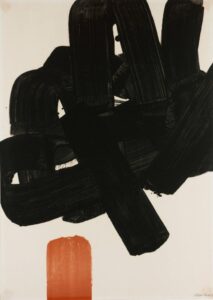Today’s post comes from Lina Kavaliunas, class of 2013 and Art Center student docent.
In 1952 the art critic Harold Rosenberg defined action painting – a method of painting employed by the American abstract expressionists of the 1940’s and 50’s – as the moment where “the canvas began to appear to one American painter after another as an arena in which to act…What was to go on canvas was not a picture but an event.”
The work of Jackson Pollock is emblematic of this sentiment. His work is inextricably linked to the process of making, the artistic performance that led to its creation. Pollock used heavily loaded brushes, sticks, and even turkey-basters to conduct paint from can to large canvases laid out on the floor of his studio. Through this process he produced works like Number 10, 1950, housed in Vassar’s own Frances Lehman Loeb Art Center, and One: Number 31, 1950, found at The Museum of Modern Art in New York. These works are seemingly spontaneous and completely free of any traditional compositional elements. However, though they appear to be devoid of any pre-meditation, the process Pollock used was not arbitrary. He carefully controlled his movements and was deeply concerned with his painterly effects.
In 1950 Hans Namuth, a young photographer, approached Pollock, asking permission to document the artist’s process. Namuth made two films and approximately 500 still photographs of Pollock between 1950 and 1956. Namuth’s records provide an explicit account of Pollock’s approach to painting. The recordings of Pollock’s process display the intensity and tension of his technique. They show Pollock bending, kneeling, and contorting himself about the canvas laid out thus revealing the artistic struggle that Pollock endured. This struggle is what gives genesis to the magnificent expressivity of Pollock’s work. The dynamic movements and self-imposed limitations of Pollock process seem to fuse the technical method of creation with the expressive message of the piece itself. The painting represents a record of the means used to arrive at an end and it is through Namuth’s work that we see these means – see the creative history of the work before us.




